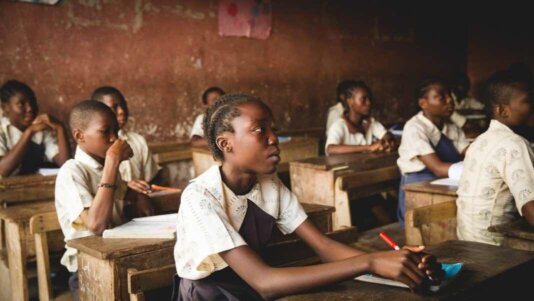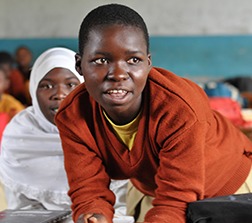- About
- Topics
- Picks
- Audio
- Story
- In-Depth
- Opinion
- News
- Donate
- Signup for our newsletterOur Editors' Best Picks.Send
Read, Debate: Engage.
| February 04, 2022 | |
|---|---|
| topic: | Child rights |
| tags: | #education, #child rights, #Zambia, #Africa |
| located: | Zambia |
| by: | Cyril Zenda |
Millions of school children in Zambia now have hopes of attaining secondary level education following the free education policy unveiled by the new government of President Hakainde Hichilema, as the southern African nation joins a few others that have completely removed the biggest barrier to access to education on the continent.
In the run-up to the August 2021 election, Hichilema promised Zambians that his government would ensure that the right to education is guaranteed for the country’s nearly eight million children by removing the monetary obstacles that made it inaccessible to the majority of citizens.
In a 8 December circular, the government revealed that the provision of free education from early childhood education to secondary school level would start in January with the government paying tuition fees through a compensatory grant.
The circular also revealed that the government was making a twofold increase in primary and secondary school grants in order to uphold quality education standards.
Zambian schools face perennial shortage of resources that range from qualified teachers, schools and classroom blocks (leading to overcrowding) to a shortage of books and other learning materials.
Setting aside a budget of 18.1 Zambian Kwacha (about $1 billion) for the education sector, the Zambian government announced the abolishment of Parent Teacher Associations (PTA), examination and tuition fees in all government schools. It also announced the recruitment of 30,000 additional teachers and plans to build 120 new secondary schools in order to reduce the teacher-pupil ratio.
The government also made additional funds available through the Constituency Development Fund (CDF) to bring relief to children from families suffering from extreme poverty - money that would allow children from remote areas to attend boarding schools as well as get such personal items like uniforms and school shoes.
The government said that it would raise the extra funding for the education sector by removing subsidies on fuel and electricity, among other initiatives.
"We said that if elected we would invest in Education," Hichilema said in a Facebook post. "Here’s where we are now: Increased teachers’ salaries; removed school fees in public schools; removed examination fees; removed PTA fees; recruiting 30,000 more teachers; providing additional funding for our most vulnerable pupils through the CDF; building 120 new schools in 2022; providing free sanitary pads for our young women in public schools; spending over k18 billion on education in our first year."
"This is a very good move," said Inonge Karaira, a Zambian national who earns a living through cross-border trading. "Although personally I could still afford paying the fees for my own children, I know many people - including many of my own relatives - whose children have dropped out of school because they genuinely could not afford," the single mother of two told FairPlanet.
As of 2021, nearly 65 percent of Zambia’s nearly 16 million citizens lived under $2 a day, with 40 percent of this poor segment of the population languishing in conditions of extreme poverty, thereby struggling to pay the average tuition fees of around k600 (about $34) charged in public schools.
School fees and other factors have always conspired to keep more than two-thirds of Zambia's 7.8 million children of school age from continuing their education, and caused half of them to drop out during the transition from primary to secondary school.
A 2015 United Nations Population Fund (UNFPA) Human Capital Development Report shows that an average of only three-in-ten Zambians of secondary school-going ages proceeded to secondary level.
"The main barrier to transitioning to secondary and tertiary education in Zambia is limited access due to inadequate schooling infrastructure and teaching personnel at these levels," the report reads. "Consequently, many children who pass their primary school exams do not make it to secondary schools because of shortage of schools. In addition, user fees at higher levels of education are unaffordable for many households."
Panic Chilufya, a Zambian media and gender specialist said that with the major obstacle to education removed, children from poor families in Zambia would be able to continue with the education.
"They will be able to pursue career paths of their choice because they will be assured of the much-needed financial support from government. That is why former South African President Nelson Mandela recognised education as a great vehicle to bring about equality in the world," said Chilufya. "He strongly believed that education is an investment as it is key to eliminating gender inequality, reducing poverty and creating a sustainable planet. It is the new currency through which nations can maintain economic competitiveness and global prosperity."
However, the new policy did not go without critique. An educationist at the University of Zambia (UNZA) who preferred anonymity, while applauding the decision to increase investment into the education sector, said that the problem with the new policy is that it appears to be a populist political decision meant more to endear Hichilema to the poor and capture their vote in future elections than to make good quality education available to all.
"The k8.1 billion is too little to make any meaningful impact to a sector that has suffered decades of neglect," the educationist told FairPlanet. "The last education budget before this policy was about k13 billion (about $730 million) yet it could not do much - so to expect this small difference to do all the things that the President is promising would be expecting a real miracle."
"There is really no need for the government to pay fees for all students, including those who can afford to pay," the educationist added, "but this being a political decision, it does not have to make sense to those outside of politics."
The UNZA education expert added that while the numbers may increase in schools, he doesn’t see the prospects of any meaningful improvement in the quality of education that is available in Zambian public schools, unless substantial investment is made in the sector.
The poor quality of education in Zambian public schools was confirmed by another UNFPA report, which attributed poor transition rates to the poor quality of education at the primary level and indicated that many children were still unable to read and write even after seven years in school.
"Reasons for poor transition rates include poor literacy and numeracy skills among primary school students, limited spaces for higher level education, and the high cost of secondary and tertiary education," the report highlighted.
"Progression into secondary and tertiary education largely depends on whether students are able to read and count while in primary school."
Zambia’s Education minister Douglas Siakalima did not respond to questions on how they hope to ensure that the already compromised education quality does not deteriorate further as has happened in other African countries where attempts have been made to make education free.
Image by bill wegene
By copying the embed code below, you agree to adhere to our republishing guidelines.

